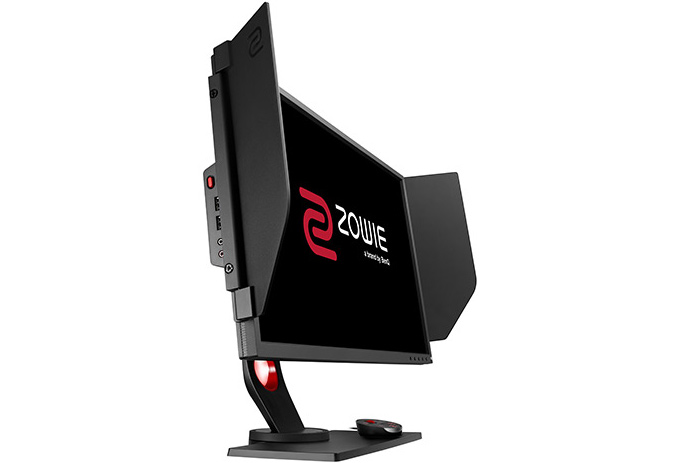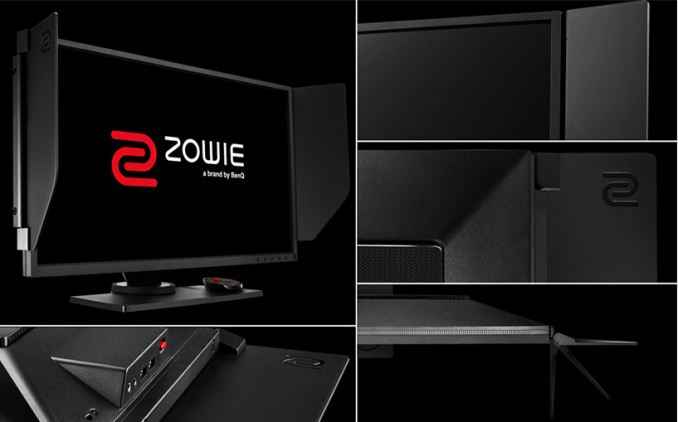BenQ Announces ZOWIE XL2546 ‘eSports’ Display: 24'', FHD, 240 Hz, DyAc ULMB Tech
by Anton Shilov on July 22, 2017 11:00 AM EST
BenQ this week introduced a new version of its ZOWIE XL2540 ultra-fast gaming display it launched last year. The improved device carrying the XL2546 model number has the same specifications as its predecessor, including a 1920×1080 resolution and a refresh rate as high as 240 Hz, but also adds BenQ’s proprietary DyAc (Dynamic Accuracy) technology designed to make fast-motion scenes a bit more clear.
The BenQ ZOWIE XL2540 monitor is one of the fastest gaming displays on the market today. The unit was launched in late 2016 and now BenQ launches its improved version, the ZOWIE XL2546 with DyAc. According to a preorder page at B&H, the new model mimics nearly the specs of the predecessor, then the new display features the same 24.5” TN panel from AU Optronics with a 1920×1080 resolution (it is the only 24" FHD panel with a 240 Hz refresh rate), supports for 16.7 million (6-bit + FRC) colors, has a typical contrast ratio for mainstream screens (1000:1), as well as offers a 320 cd/m2 brightness, which is lower compared to what the XL2540 offers (400 cd/m2). For some reason, with the ZOWIE XL2546, BenQ continues to ignore AMD’s FreeSync and NVIDIA’s G-Sync dynamic refresh rate technologies.
Two main features of the ZOWIE XL2546 display are its native 240 Hz refresh rate as well as the company’s DyAc (Dynamic Accuracy) technology that enhances the display's motion clarity. The manufacturer does not explain anything about this tech, but from various media reports (e.g., this one) it appears that the DyAc is BenQ's implementation of Ultra Low Motion Blur backlight strobing. ULMB reduces motion blur by inserting a black image between each frame of video and thus reducing time each frame is displayed. Given the hardware similarities between the monitors, I'm left to ponder of BenQ could have enabled this in current monitors via a firmware update, but for some reason BenQ decided not to add it to the ZOWIE XL2540, but to launch a new display instead.
Other interesting capabilities of the ZOWIE XL2540/XL2546 are the Black eQualizer that increases the brightness of dark areas without oversaturating the bright areas, an option to quickly increase color vibrancies, a special external controller to activate different settings and profiles rapidly, as well as a light-shielding hood (which BenQ calls a way to help gamers to focus on their games).
Just like the XL2540, the XL2546 uses DisplayPort 1.2, HDMI, and DVI-DL to connect to host PCs (though it should be noted that DVI does not support a 240 Hz refresh rate). In addition, the monitor has an integrated three-port USB hub and a PSU.
BenQ plans to showcase the ZOWIE XL2546 display at DreamHack Atlanta 2017 this weekend. The company does not disclose anything regarding the price or the ETA of the new unit officially, but B&H is charging $549 for the new unit, which is $50 higher compared to its predecessor.
Related Reading:
- BenQ Announces the ZOWIE XL2540: 24-Inch 240 Hz Full-HD Display 'for e-Sports'
- BenQ PD2710QC Announced: 27" 2560x1440 with Integrated USB Type-C Dock
- BenQ Launches the SW320: a 4K Display with HDR for Professionals
- Samsung Announces First Freesync 2 Monitors: CHG70 & CHG90 - Quantum Dots, Up to 49”, 144 Hz, DCI-P3
- Acer Predator X35 & ASUS ROG Swift PG35VQ Unveiled: 35-inch G-SYNC HDR Monitors - UltraWide, Curved, 200Hz
- AOC Launches the AG352QCX: 35-Inch 200 Hz 2560×1080 Curved Display with Adaptive-Sync
- Acer Predator Z35P Available for Order: Curved 35" with 3440×1440@120 Hz and G-Sync
- Acer Predator Z271UV Gaming Monitor: 1440p, 144-165Hz, G-Sync, Eye Tracking
Source: BenQ











40 Comments
View All Comments
cfenton - Saturday, July 22, 2017 - link
Are these expensive TN panels any better than the ones in $150 monitors, or do they still have terrible colors and viewing angles? Or, are you paying an extra $400 just for the refresh rate?Santoval - Saturday, July 22, 2017 - link
It is a 6 bit TN panel (I thought these had stopped being made), so expect both colors and viewing angles to be atrocious. With extensive color banding as well. 6 bit + FRC does not output 8 bit colors, more like ~6.5 bit ones.Lord of the Bored - Sunday, July 23, 2017 - link
Six and a half bits? Really? Six AND A HALF bits?StevoLincolnite - Sunday, July 23, 2017 - link
He isn't wrong though. FRC doesn't magically add bits. It's improvement is pretty marginal.JoeyJoJo123 - Monday, July 24, 2017 - link
6-bit + FRC is largely equal to an 8-bit color depth display.TFTCentral has already made reviews on AU Optronic's 240hz 1080p 24.5" TN panels, they make no mention of any ill effects caused by the modern FRCs used in these AU Optronics panels.
http://www.tftcentral.co.uk/reviews/asus_rog_swift...
http://www.tftcentral.co.uk/reviews/aoc_agon_ag251...
Additionally, TFTCentral has this section in their FAQ:
http://www.tftcentral.co.uk/faq.htm#colour_depth
"An 8-bit display would offer a colour palette of 16.7 million colours. They offer a 'true' colour palette, and are generally the choice of manufacturers for colour critical displays over 6-bit panels. On the other hand modern 6-bit screens use a range of Frame Rate Control (FRC) technologies to extend the colour palette from 262,144 colours to around 16.7m. In fact on many modern panels these FRC are very good and in practice you’d be hard pressed to spot any real difference between a 6-bit + FRC display and a true 8-bit display. Colour range is good, screens show no obvious gradation of colours, and they show no FRC artefacts or glitches in normal everyday use. Most average users would never notice the difference and so it is more important to think about the panel technology and your individual uses than get bogged down worrying about 6-bit vs. 8-bit arguments."
Any argument against usage of FRCs is largely asinine internet banter that really doesn't amount to anything. The fact of the matter is that you shouldn't care about 6-bit + FRC or 8-bit unless you have golden eyes and have historically worked with various color depth displays in a professional environment for professional image or video work, in which case *NEWS FLASH* this isn't a display intended or marketed for professional image or video work.
Hell, you could be typing on a 6-bit + FRC display right now and you wouldn't know unless you actually dismantled the display looked up the panel's specifications online.
Jedi2155 - Tuesday, July 25, 2017 - link
Try to make the image like this look the same on a 6 bit + FRC TN versus an IPS then I say you'd go mad. I tried lol.https://4.bp.blogspot.com/-ysumqH8rUDo/VbezIHAMNQI...
Honestly, the dynamic range of a 6-bit + FRC becomes a huge issue when those colors ranges are needed in the same image. The window of available colors simply results in a duller image on a TN vs. a true 8-bit. I have one of the latest TN ultra wide viewing angles with 6 bit+FRC and while color production is sigifnicantly improved it still can't compare my IPS displays from 2002 / 2010 etc.
Santoval - Saturday, July 22, 2017 - link
p.s. That price is a proper rip-off, really.ridic987 - Saturday, July 22, 2017 - link
I own the XL2540 and its about the same image quality as a 150 dollar tn. It really is just the refresh rate.nerd1 - Sunday, July 23, 2017 - link
Play any competitive FPS game and you'll INSTANTLY notice why refresh rate matters.I have multiple high-res IPS monitors with 100% adobe coverage but I play game on my 144hz TN monitor.
Flunk - Sunday, July 23, 2017 - link
Quite seriously, the high refresh-rate TN screens still have hugely worse response rates (CRTs have basically none) and lower input lag than CRTs. So if this was a big issue you'd be using one of those.The difference between actual pixel response between regular TN screens and the pricey high priced gaming ones isn't much, especially if you compare to a CRT which redraws the entire picture from blank completely for every frame.